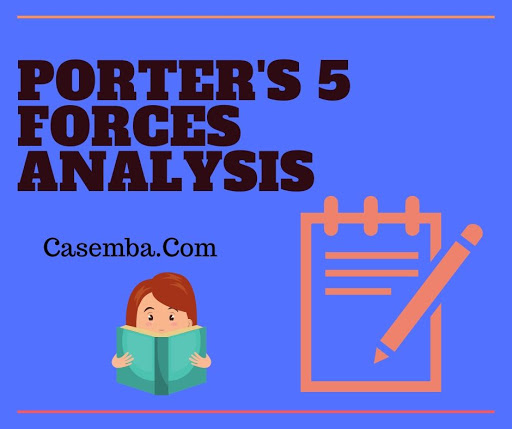Porter's Five Forces of Bank Of Tokyo Case Study Analysis
This is not the actual case solution. To get the case solution place your order on the site and contact website support.
Home >> Robert F Bruner >> Bank Of Tokyo >> Porters Analysis
Porter's 5 Forces of Bank Of Tokyo Case Analysis
The porter 5 forces design would assist in getting insights into the Porter's Five Forces of Bank Of Tokyo Case Help market and determine the probability of the success of the alternatives, which has been considered by the management of the company for the function of handling the emerging problems connected to the minimizing subscription rate of clients.
1. Intensity of rivalry
 It is to inform that the Porter's Five Forces of Bank Of Tokyo Case Analysis is a part of the international show business in the United States. The business has been taken part in providing the services in more than ninety nations with the video on demand, products of streaming media and media service provider.
It is to inform that the Porter's Five Forces of Bank Of Tokyo Case Analysis is a part of the international show business in the United States. The business has been taken part in providing the services in more than ninety nations with the video on demand, products of streaming media and media service provider.
The industry where the Porter's Five Forces of Bank Of Tokyo Case Analysis has been operating since its beginning has many market players with the considerable market share and increased incomes. There is an extreme level of competition or rivalry in the media and show business, compelling companies to make every effort in order to retain the present clients through using services at budget friendly or reasonable prices. Porter's 5 Forces of Bank Of Tokyo Case Help has actually been dealing with fierce competitors from the competing companies using on demand videos, conventional broadcaster and sellers offering DVDs. The main direct competitor of Porter's 5 Forces of Bank Of Tokyo Case Solution is Amazon, because both of these companies provide DVDs on lease, for this reason contending in this domain for the similar target audience.
Quickly, the intensity of rivalry is strong in the market and it is necessary for the company to come up with distinct and innovative offerings as the audience or clients are more advanced in such modern technology period.
2. Threats of new entrants
There is a high expense of entrance in the media and entrainment market. The entertainment industry needs a large capital quantity as the business which are engaged in providing home entertainment service have larger start-up expense, which includes:
Legal cost.
Marketing expense.
Distribution cost.
Licensing cost.
On the other hand, the existing entertainment service provider has actually been extensively working on their targeted segments with the particular expertise, which is why the hazard of brand-new entrants is low.
Another important factor is the intensity of competitors within the crucial market players in the market, due to which the brand-new entrant be reluctant while entering into the market. The technology and patterns in the media market are developing on constant basis, which is adjusted by market competitors and Porter's Five Forces of Bank Of Tokyo Case Help.
3. Threat of substitutes
The hazard of substitutes in the market position moderate risk level in media and the home entertainment industry. The customer might also engage in other leisure activities and source of details as compared to viewing media material and online streaming.
4. Bargaining power of buyer
The characteristics of media and entertainment market allows the consumers to have high bargaining power. The low cost of changing enables the customers to look for other media service providers and cancel their Porter's Five Forces of Bank Of Tokyo Case Analysis subscription, thus increasing the company threat.
5. Bargaining power of suppliers
Because Porter's 5 Forces of Bank Of Tokyo Case Solution has been competing versus the traditional supplier of entertainment and media, it needs to show higher versatility in contract as compared to the conventional businesses. The products is technology based, the dependence of the business are increasing on continuous basis.
Objectives and Objectives of the Company:
In Illinois, United States of America, among the greatest manufacturer of sensing unit and competitive organization is Case Service. The organization is associated with production of large product variety and development of activities, networks and processes for succeeding among the competitive environment of industry giving it a substantial advantage over competitiveness. The company's goals is mainly to be the maker of sensing unit with high quality and extremely personalized company surrounded by the premium market of sensing unit production in the United States of America.
The goal of the company is to bring decrease in the item prices by increasing the sales unit for each item. The organizational management is involved in decision of prospective items to use their client in both long term and brief term means. The organizational strength includes the facility of competitive position within the production market of sensor in the United States of America on the basis of 5 pillars which includes client care, performance in operation management, acknowledgment of brand, adjustable abilities and technical innovation.
The organization is a leading one and carrying out as a leader in the sensor market of the United States for their personalized services and systems of sensing unit. Innovation in ideas and item designing and provision of services to their consumers are among the competitive strengths of the company. The company has used cross-functional supervisors who are responsible for adjustment and understanding of the company's method for competitiveness whereas, the company's weakness includes the choice making in regard to the items' removal or retention just on the basis of monetary elements. The measurement of ROIC is not associated with the trade incorporation and issues of customers.
